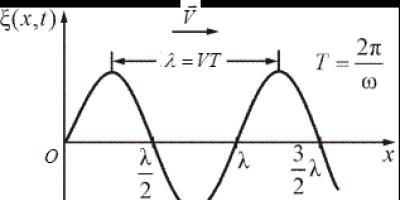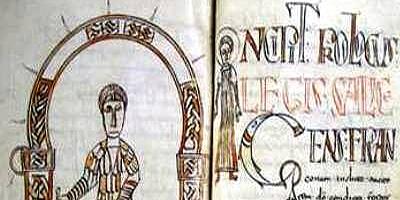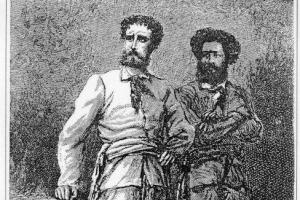Currently, there are two points of view on the issue of Nautilus. According to the first of them, the writer not only foresaw the appearance of a submarine, but also endowed it with properties unattainable by modern technology. Opponents of this view argue that the development of modern technology has outpaced Jules Verne's dream. Both are wrong, since he did not predict the submarine that existed before him, and, moreover, the bold fantasy of the writer, who endowed the Nautilus with the ability to descend to any depth and not be crushed, is not able to embody modern technology that uses reaching the deep layers of the ocean is not submarines, but bathyspheres and bathyscaphes.
It is interesting that J. Verne was able to foresee the use of electricity to drive all the mechanisms of the Nautilus, because at that time there were no incandescent light bulbs or electric motors. His “errors and inaccuracies” (largely outdated classification, ease of movement in spacesuits, etc.) are not errors, but a reflection of the level of the cutting edge of science at that time. His captivating novel is by no means a textbook on ichthyology, and, as Prof. rightly states in his comments to the novel. Zenkevich, the development of science cannot make J. Verne “obsolete,” since for the reader in his novels the main thing remains “the affirmation of the will, reason and poetry of scientific work aimed at conquering the immense forces of nature.”
To most of the writer’s contemporaries, the idea of a round-the-world underwater trip seemed unrealistic due to the lack of practical results from the attempts of the inventors of submarines, but he himself was firmly convinced that “Nautilus” was not a groundless fantasy and would sooner or later become a reality. Later, submarines re-designed by the imagination of J. Verne appeared in “The Lord of the World” and in “The Flag of the Motherland.” In the novel “Twenty Thousand Leagues Under the Sea” the focus is on the image of the mysterious Captain Nemo, in whom there is something in common with the heroes of Byron’s “Eastern Poems”. It is no coincidence that he is an Indian, which modernized the Byronic hero, connecting him with the liberation struggle of the peoples in India (the sepoy uprising), and gave him genuine significance. Shrouded in a veil of dark mystery, Nemo, like Byron’s heroes, individualistically solving the problems of good and evil, becomes an individualistic avenger, breaking with the “civilized” world. In his portrait, romantic uncertainty is combined with clearly realistic features: thin hands with elongated fingers characterize the passion and nobility of nature, and wide-set eyes reveal the mind of an insightful scientist. This portrait says that J. Verne’s teacher was the master of realistic portraiture - Balzac, but if he appealed to the authority of Gall and Lavater, then the physiognomistic observations of the narrator are supported by a reference to Grascole and Engel.
Nemo considers it generous in his decision to hold Aronnax and his companions as eternal captives, assuring as a scientist to a scientist that the professor will not regret it if he becomes a participant in scientific research. This is how the extensive exposition ends and the theme of a fantastic journey under the water begins - the main theme of the novel, and the display of the wonders of the underwater world is constantly intertwined with the ever-deepening characterization of the central character. The extraordinary breadth of Captain Nemo's interests is evidenced by his library, which contains pearls of world literature from Homer to J. Sand and scientific works on various branches of natural science and technology. The paintings and scores in the same library speak of a subtle understanding of painting and music. Jules Verne masterfully uses the realistic technique of carefully describing the interior as a means of in-depth characterization of the hero. He brings the true passion of a scientist into his research and shows amazing ingenuity, although he declares to Aronnax that his works will never reach humanity. Nemo claims that the desire for true freedom forced him to hide under the waves of the ocean: “The sea is not subject to despots... Here, only here, is real independence! There are no tyrants here. Here I am free! Declaring his break with society, he actively helps oppressed nations and nationalities, possessing an untold wealth of underwater treasures. Unlike Childe Harold, who does not take part in the struggle, Captain Nemo actively takes revenge and just as actively helps the fighters for independence. He does not want to harm the poor Papuans, victims of colonial expansion, and without hesitation, he throws himself at a tiger shark with a knife to save the life of the poor Indian. This is a strong and passionately feeling person, terrible in anger and hatred, but sincerely mourning his dying comrades. The colossal strength of his hatred of his oppressors is evidenced by the sinking of the English battleship that attacked the Nautilus. Having unfurled a black flag (in India, black is considered the color of rebellion), he gloomily observes the agony of the sinking ship, but in his cabin he bursts into sobs, and this contradictory behavior emphasizes the depth of the experiences of this extraordinary man, who appears to Aronnax as a titan, the ruler of the waters. This is a mystifying romantic device, according to which Gobsek grew into a terrible symbol of the power of gold in the eyes of the shocked Derville.
Admiring the ocean - a symbol of freedom (again a roll call with Byron), Nemo dreams of some kind of underwater utopia, where cities free from the power of despots will rise to the surface in the morning to replenish air supplies. When the narrator begins to talk about creating a continent with the help of coral polyps, Nemo dryly interrupts him: “We need new people, not new continents!”
As for his entourage, the faceless sailors from the Nau-tilus, whose community includes representatives of various nations, are all infinitely devoted to him.
Before the bright image of Nemo, the personality of the narrator also fades - another version of a scientist, not a genius like Nemo, but not an eccentric like Paganel. Aronnax is a correct, intelligent person, but hardly an outstanding scientist. Humane and kind-hearted, he is driven by a sense of abstract justice (the author continues to believe in the high educational role of science), and is democratic, which is manifested in his attitude towards Conseil, more a friend than a servant. Having become a prisoner of the Nautilus, Aronnax experiences a truly “Faustian conflict” between the thirst for liberation and the desire to continue exploring the depths of the sea and its inhabitants, but the first desire turns out to be stronger, since he is not going to wander with Nemo all his life and wants publish your book about the sea to benefit people.
His level-headed Fleming servant is a jack of all trades and extremely knowledgeable in the theory of classification. However, in practice, a zealous classifier cannot distinguish a sperm whale from a toothless whale, or tuna from a mackerel, unlike the harpooner Ned Land, who names any fish without hesitation. The author, not without humor, notes that together they would make a wonderful naturalist. Humor, having entered the novel along with the eccentric Conseil, accompanies the presentation of scientific material, which is constantly wedged into the fabric of the novel. Even half-paralyzed by the blow of an electric stingray, the incorrigible classifier mutters in a trembling voice: “class cartilaginous, order cartilaginous, etc.
The king of harpooners, Ned Land, recognizes only the taste classification of fish into edible and inedible. His conversations with Conseil become a means of humorous introduction of scientific materials that are organically included in the narrative. Only rarely are these materials presented in a serious manner, and most often they are humorously colored to enliven the narrative.
The main theme of the novel - the theme of a fantastic journey - ends with the escape of three captives, but the secret of Captain Nemo remains unsolved.
Intertwined with this theme is the barely outlined theme of Atlantis, which has invariably attracted modern science fiction writers, starting with Conan Doyle (“The Abyss of Marakot”). This theme was only delivered by Jules Verne, but the main theme was masterfully developed. A unique exposition includes reports of a floating reef, comic excitement around a mysterious sea monster, and the organization of an expedition in search of a mysterious narwhal. The plot is the moment when Aronnax realizes that this is not a monstrous natural phenomenon, but the creation of human hands - an extraordinary underwater ship, and the further journey becomes a display of miracles created by the genius of man, immeasurably superior in their fantasticness to the wonders of nature. Moreover, Captain Nemo himself plays the traditional role of a guide, introducing the shocked alien to the wonders of technology and the underwater world. The very introduction of scientific material takes on a fantastic character, as exemplified by underwater landscapes observed either through the viewing windows of the cabin or during underwater walks. The interior becomes not only a means of in-depth characterization of Captain Nemo - a musician, artist, scientist and brilliant engineer, but also a means of introducing science fiction material. Not only the dining room, but also Aronnax’s first breakfast illustrates Ne-mo’s fantastic thesis: the sea feeds and clothes the crew of the Nautilus, and the working compartments of the underwater ship demonstrate fantastic technology.
Since, according to the plan, the story of a fantastic journey is told as if with protocol precision, there is no room left for tropes. Comparisons are extremely rare and condensed, sometimes humorously colored. When the Nautilus finally escaped from the ice captivity, which threatened death from suffocation, Ned Land only silently opens his mouth, “but in such a way that even a shark would be scared.” Drawing the excitement around reports of a mysterious monster that has become fashionable, the author sarcastically notes that “the opportunity has opened for newspaper ducks to lay eggs of all colors,” revealing this satirical metaphor with a whole set of fantastic tales about monstrous whales, octopuses and sea snakes .
When Aronnax, preparing to escape, remembers everything he experienced during the journey, it passes before him “like a moving set in a theatrical background” - here the function of comparison is different, it emphasizes that the role of the narrator is that of an outside observer, rather than an active participant in the events depicted.
Its brief content helps to understand the features of the work. “20 Thousand Leagues Under the Sea” is one of the most famous novels by the famous French science fiction writer J. Verne. The author became famous for skillfully combining the science fiction genre with exciting action in his writings. In his books, an adventurous plot organically accompanies a dynamic story, in which extraordinary personalities become participants. They overcome difficult obstacles with the strength of their spirit, will and perseverance and ultimately achieve what they want.
Jules Verne became a true master of a fascinating plot. “20 Thousand Leagues Under the Sea” is a novel that would be the envy of any modern blockbuster. After all, it has everything: an exciting story that does not let the reader go until the end of the story, interesting characters, a colorful background.
The book begins with a ship sent to the open sea to find out the origin of a mysterious creature that sinks ships. On board are the scientist, Professor Aronnax, his secretary Conseil and harpooner Ned Land. During the journey, the ship encounters this mysterious animal. As a result of the shock, the three heroes found themselves in the open ocean, but they are saved on the surface of a mysterious object, which turned out to be not a monster, but a submarine. Its captain left his friends on board as prisoners, because he did not want the secret of his invention to become known to anyone else.
He himself hid from human society and forever fell in love with the ocean, about which he said: “The sea is eternal movement, and love, and life.” He devoted himself entirely to studying the underwater depths. And in this regard, I quickly found a common language with the professor. The novel “20 Thousand Leagues Under the Sea,” whose main characters had the opportunity to make an amazing trip around the world, is dedicated to a description of the underwater world, as well as the adventures of its crew.
Captain Nemo
A brief summary will help schoolchildren understand J. Verne’s books. "20 Thousand Leagues Under the Sea" is a work that is the best example of science fiction. The story is told on behalf of Professor Aronnax. Together with his three friends, by chance he found himself on board a submarine.
However, the main character is her owner, Captain Nemo. This person is mysterious in every way. The author discovered its origin only in the final part of the trilogy (“The Mysterious Island”). However, even without this, this person arouses interest among readers with the depth of his knowledge, extraordinary intelligence and love of freedom.
Thus, we learn that he helps oppressed peoples fight for independence. And it was not for nothing that Vern put into his mouth the following phrase, imbued with humanistic pathos: “We need new people, not new continents!” At the same time, the captain is cruel in his anger. Avenging the death of his loved ones and comrades, he sinks English ships, terrifying many sea powers.

Professor Aronnax
Fans of the works of J. Verne may be interested in their summary. “20 Thousand Leagues Under the Sea” is an amazing story about how the narrator, along with his assistant Conseil and the harpooner Land, ended up on the submarine Nautilus.
Finding themselves in the position of honorary prisoners of her captain, they nevertheless had the opportunity to make an exciting trip around the world under the ocean and witness unforgettable events. It is thanks to the professor that the reader gets acquainted with the underwater fauna, and also experiences adventures with him: a walk through Atlantis, sea hunting, penetration into the mouth of a volcano and many others.
A brief summary of the work will help you get an idea of the characters in the work in question. "20 Thousand Leagues Under the Sea" is a novel whose characters are distinguished by carefully written characters. The professor's personality evokes deep sympathy: he is smart, educated, and accommodating. The author puts into his mouth a phrase full of deep humanistic meaning: “Every person, just because he is a person, is worthy of thinking about him.”

Conseil
A brief summary helps to understand the characteristics of the characters in the work. “20 Thousand Leagues Under the Sea” is a book whose characters are as original as the plot. Professor Conseil's assistant turned out to be especially colorful. This is an imperturbable and phlegmatic young man who is completely devoted to his master and science.
So, during a shipwreck, he jumped into the sea after him, risking his life. During the voyage of the Nautilus, he more than once helped his comrades with his advice. This character also carries a comedic load, as he constantly flaunts scientific terms throughout the story. In addition, his composure and equanimity, even in the most critical moments, will more than once make the reader smile.

Ned Land
Jules Verne is rightfully considered one of the most famous science fiction writers. 20 Thousand Leagues Under the Sea is the best example of science fiction. In addition, the writer gave the reader interesting characters for whom you really want to worry and sympathize.
Ned Land is a harpooner who also fell into the sea during a shipwreck. This is a very simple, practical, open person who His comments about the adventures happening to him will more than once make the reader smile: “I don’t regret that I had the opportunity to make an underwater trip. I will remember it with pleasure, but for this it must end.” At the same time, he is a very enterprising and energetic man. So, it was he who organized and arranged the escape from the Nautilus.

Place in the author's work
20 Thousand Leagues Under the Sea is a novel that is part of an adventure series written by Verne. This is an outstanding work in which the writer’s creative principles are most fully reflected. Perhaps, it was in this book that he managed to immerse his reader in the world of science and technology in the most fascinating way. The work “20 Thousand Leagues Under the Sea,” quotes from which prove the author’s humanistic pathos, is still loved by readers today.
TWENTY THOUSAND LEAGUES UNDER THE WATER Novel (1870) Nemo, captain (Prince Dakkar) - explorer of the depths of the sea, inventor and owner of the fantastic submarine "Nautilus", which from time to time appears on the surface of the seas, is perceived by everyone as a kind of supernatural and dangerous representative of cetaceans, becoming an object not only of curiosity, but also of hunting. The ship "Abraham Lincoln", which specially went in search of an unknown "animal", is defeated in a battle with it. Miraculously surviving natural scientist Pierre Aronnax, his servant Conseil and whaler Ned Land end up on board the Nautilus, become prisoners of N. and travel with him around the world, traveling twenty thousand leagues under water; These events form the plot of the novel of the same name. The name of the hero is symbolic (Latin Nemo - no one). N.'s past, his conflict with society, which led to the final break, and his real name are shrouded in mystery. Flight from the world and the lack of clarity of its motivation, spiritual loneliness, kinship with a powerful element - all this gives N.'s appearance the features of a romantic hero. The narration is told on behalf of Pierre Aronnax, who, understanding the uniqueness of N.’s personality, tries to be objective.
Constantly declared hatred of humanity, which in N.’s mind is identified with the idea of violence and injustice, and his periodic search for contact with people; passionate love of freedom and deliberate confinement of oneself in the limited space of the Nautilus; sometimes terrifying severity, emphasized restraint and moments of spiritual liberation given to playing the organ - such obvious contradictions cannot escape the gaze of a close observer, which is Aronnax. However, the atmosphere of mystery is maintained almost until the end of the story. Only in the last chapters of the novel “The Mysterious Island” does the author shed light on the secret of N., who turns out to be the omniscient and omnipresent patron of the island on which the described events, typical of a Robinsonade, unfold. N. saved the lives of the inhabitants of the island, who, not knowing to whom they owed their lives, trusted in him as providence. His Nautilus found its final refuge in the waters of the Pacific Ocean. Feeling the approach of death, N. decides to reveal himself to people: impulses of compassion, the desire to help them melted the ice of misanthropy in him.
Telling the story of his life, half of which was spent in voluntary imprisonment at sea, N. appears as a spiritual brother of romantic heroes, whose fate is always injustice and persecution. An Indian by birth, brilliantly gifted and having received a comprehensive education in Europe, Prince Dakkar (this is N.'s true name) led an uprising against English rule in his homeland; the uprising ended in defeat. Death did not spare any of Dakkar's friends or family members. Filled with hatred for everything that happens in the world, which does not know what freedom and independence are, he found refuge from the evil happening in the world under water, in the depths of the seas.
Sailors first saw this “long, phosphorescent, spindle-shaped object” of enormous size in 1866. It moved incredibly fast and spewed powerful jets of water into the air. Scientists considered the object to be a huge sea monster, and journalists and cartoonists turned it into a popular joke.
In 1867, a steamship encountered the “monster”, and a little later it itself attacked a mail ship, making a triangular hole in the bottom of the ship sheathed with sheet iron. Sailing the seas has become dangerous. When the world's largest countries declared that they had not created a submersible, scientists were finally convinced that the object was a huge cetacean. Professor of the Paris Museum, naturalist Pierre Aronnax suggested that this was an unusually large narwhal that rose from the ocean abyss and attacked the ship with its sharp horn.
The monster had to be destroyed. The fast frigate Abraham Lincoln was equipped for this purpose. Together with forty-year-old Aronnax and his faithful, phlegmatic servant Conseil, thirty years old, the best Canadian whaler Ned Land, a tall, strong man with a strong-willed and explosive character, was included in the expedition. The ship, under the command of Captain Faragut, equipped with the latest technology, headed to the Pacific Ocean, where the “narwhal” was seen for the last time.
On the way, the professor and the whaler became friends. Stubborn Ned, the only one of the entire team, did not believe in the existence of the “giant narwhal”, considering all the stories about him to be newspaper “ducks”. The captain promised $2,000 to the first person to spot the monster. Dozens of eyes watched the ocean, but the “narwhal” still did not appear. Three months later, the frigate's crew lost their last hope. At noon on November 5, the captain turned “towards the European seas,” and late in the evening the sharp-eyed Ned Land saw the “narwhal.” The captain tried to catch up with the monster all day on November 6, but it eluded, infuriating Faragut and Ned. The iron cores of a special cannon bounced off the skin of the narwhal. In the evening the frigate managed to get closer. Ned threw his harpoon, which bounced off the monster's back with a metallic clang. The Narwhal unleashed powerful jets of water onto the deck, which washed Aronnax into the ocean.
Having come to his senses, the professor found the faithful Conseil nearby, who jumped after his master. There was no hope for rescue - the frigate's propeller was broken, and the ship could not return. After staying on the water for several hours and exhausted, Aronnax and Conseil heard someone’s voice and swam towards the sound. Soon the professor came across some solid body and lost consciousness. He woke up on the back of a narwhal in the company of a servant and Ned Land. The whaler was thrown into the water during the collision, but he quickly climbed onto the back of the monster, which turned out to be iron.
Suddenly the ship started moving. Some time later, his speed increased so much that the friends had difficulty staying on the surface. Feeling that the ship was sinking, the friends began knocking on the metal plating. “Eight stalwarts with covered faces” came out of the hatch and led them inside the underwater ship.
The prisoners were locked in a room lined with sheet iron. After some time, a tall, handsome man with a proud posture and a firm, calm gaze entered them. He pretended that he did not understand a single European language and soon left the room. The friends spent several days in their dungeon. All this time the submarine was in motion, and Ned Land was angry and made plans to escape.
Their imprisonment was broken by the same handsome man. He spoke to the professor in French and called himself Captain Nemo (in Latin - Nobody). The captain intended to give his prisoners complete freedom within the ship if they promised not to interfere in his affairs. Aronnax realized “that a terrible secret was hidden in this man’s past.” He broke all ties with the earth. His captives were doomed to the same thing.
Nemo's ship, the Nautilus, was built according to the captain's drawings. Parts of the Nautilus, manufactured in different countries, were assembled together at Captain Nemo's own shipyard. The boat moved using electrical energy obtained from huge sodium batteries. The ship's crew received everything they needed for life from the ocean. Even the fabric for clothing was made from seaweed. The Nautilus rose to the surface only to determine its location, renew its air supply and hunt in a special waterproof boat, which was stored under the outer ledge on the ship's hull. Having received a promise from his friends, Nemo showed Aronnax all the wonders of the Nautilus, including a capacious library and a salon-museum with the wonders of the deep sea. The captain gave the professor a cabin next to his and invited him to participate in his scientific research. The prisoners did not communicate with the ship's crew - the sailors spoke some kind of artificial language and were completely devoted to the captain. Nemo considered the crew of the Nautilus his family.
Nemo was going to travel around the world through the oceans of the Earth. Having determined his location for the last time, he plunged the ship 50 meters and headed east-northeast along the Kuro-Sivo (Black River). On that day, November 8, the friends first saw the wonders of the depths through the thick crystal portholes of the Nautilus, which were closed with iron shutters and opened for several hours a day. On November 10, Aronnax began keeping a diary on seaweed paper.
Five days later, the professor and his companions received a written invitation from Nemo to hunt in the forests of Crespo Island. Ned Land immediately thought of escaping, but to his disappointment the hunt turned out to be underwater. The harpooner did not dare to put on a rubber spacesuit with a copper helmet, equipped with a compressed air cylinder and a lighting apparatus. Together with Nemo and the silent members of his team, Aronnax went hunting with the faithful Conseil, who did not lag behind his owner a single step. The scientist was amazed by this underwater walk through the kelp forest. Nemo demonstrated miracles of accuracy, killing an albatross hovering above the water with an air gun. The friends returned to the Nautilus, shooting a sea otter and narrowly avoiding sharks.
In the following weeks, the professor met with Nemo very rarely. Every morning the Nautilus surfaced to determine coordinates, and in the afternoon the captain opened the shutters on the windows. On November 26, the submarine crossed the Tropic of Cancer, passed the Sandwich Islands and headed further southeast past Hawaii and the Marquesas Islands. Aronnax saw all these archipelagos only from afar. Having passed the Tropic of Capricorn, the Nautilus turned west-northwest and passed the island of Tahiti. By this time the ship had traveled 8,100 miles.
On January 4, the Nautilus approached the Torres Strait, which separated Australia from New Guinea. Many ships perished in this dangerous strait, but Nemo decided to pass through it and ran aground near the island of Gweboroara. Calling this incident an “accidental disturbance,” the captain began to calmly wait for the full moon on January 9, during which a strong tide would begin and refloat the submarine. Aronnax doubted that the tide would help, but Ned was sure that the Nautilus would no longer have to plow the oceans.
Taking advantage of the forced stop, the friends asked to go ashore, where they stocked up on fresh meat, which Ned missed so much. Their hunt, which lasted several days, was interrupted by a crowd of bloodthirsty natives. Friends were forced to hide from them on the Nautilus. Having overcome fear, the Papuans attacked the submarine. Despite Nemo's calmness, the friends gathered to fight the cannibals, but at that time the tide began to rise, and the Nautilus rose from its coral bed." The ship headed for the Indian Ocean.
Nemo was constantly engaged in scientific research. While talking about studying the density of sea water, the captain mentioned the Mediterranean Sea. Aronnax concluded that Nemo also happens in densely populated areas. On January 18, the Nautilus did not dive for a long time - Nemo seemed to be waiting for someone in the middle of the desert ocean. Through a telescope, Aronnax noticed a ship on the horizon, but then the captain knocked the pipe out of his hands and demanded that he fulfill his promise. Friends had to obey. So that they would not see anything unnecessary, sleeping pills were mixed into their food.
Waking up, the professor met with Nemo, who asked him to provide medical assistance to a wounded member of the Nautilus crew. The sailor's skull was fractured, and Aronnax could do nothing to help him. The unfortunate man was buried at the bottom of the ocean, where Captain Nemo built a small cemetery for his loved ones.
Part two
After this strange incident, Aronnax was at a loss: who was the mysterious Captain Nemo - a scientist, an unrecognized genius, or an avenger. The friends still remained prisoners of the Nautilus, but the freedom-loving Ned Land did not lose hope of breaking out of the underwater prison. Aronnax, on the contrary, wanted to complete his trip around the world and finish his new scientific work. Conseil also received considerable pleasure while doing his favorite thing - classifying the inhabitants of the underwater world.
On January 26, the Nautilus crossed the equator, and on January 28, it approached the island of Ceylon. Here Nemo took his friends on a walk along the pearly shallows of the Gulf of Manara. There were many sharks in this bay, so the professor accepted the captain’s invitation without enthusiasm, but did not dare refuse, thereby admitting his cowardice. To his surprise, neither Ned nor Conseil were frightened by the news of the sharks. This time the friends were not given guns - Nemo armed them only with daggers. First of all, the captain took his companions to an underwater grotto and showed him a huge shell in which a pearl the size of a coconut was ripening. Nemo grew this jewel for his museum.
Coming out of the grotto, the companions saw how a shark attacked an Indian pearl fisherman. Nemo rushed at her with a knife. A fight ensued. The wounded shark crushed the captain with its carcass and opened its mouth full of terrible teeth. At that moment, Ned Land struck the fish with a spear, which he had prudently taken with him, and saved Captain Nemo’s life. Having brought the Indian to his senses, the captain gave him the pearls collected during the walk. Aronak noticed that compassion had not yet died in Nemo. In response, the captain declared that he would always be a defender of the oppressed.
On February 7, the ship passed the Gulf of Aden and entered the Red Sea, from which, according to Aronnax, there was only one way out. Nemo, however, intended to cross from the Red Sea to the Mediterranean through a passage known only to him, located under the Isthmus of Suez. The captain called it the Arabian Tunnel. Ned Land, skeptical as always, nevertheless hoped to get into the Mediterranean Sea and escape.
Nemo crossed the tunnel on the night of February 11th. The transition was witnessed by Aronnax, who was kindly invited into the captain's cabin, protruding above the hull of the Nautilus and protected by thick crystal glass. The passage through the tunnel, illuminated by the ship's powerful searchlight, took several minutes. In the morning, seeing Port Said in the distance, Ned again started talking about escaping, but the professor did not want to part with the Nautilus and the opportunity to explore the inaccessible corners of the oceans. Conseil agreed with Aronnax, and Ned remained in the minority. The harpooner believed that Nemo would not let them go of his own free will and made the professor promise to escape at the first opportunity. Ned wanted to get under the waterproof casing of the boat and emerge with it when the Nautilus was near the inhabited shore.
On February 14, Aronnax noticed that the captain was waiting for something. While observing the sea inhabitants, the professor noticed a swimmer who turned out to be an acquaintance of the captain. Seeing him, he took gold bars from the safe, filled a large chest with them and wrote the address in Greek. The mighty sailors pulled him out of the cabin, and soon the boat set sail from the Nautilus.
Nemo did not like the Mediterranean Sea, and the Nautilus crossed it in 48 hours. The speed of the ship was so great that Ned had to forget about escape. On February 18, the submarine entered the vast Atlantic Ocean. The harpooner decided not to wait for the Nautilus to leave the inhabited areas, and scheduled the escape for the evening. Finding no peace, Aronnax went into the captain's cabin, the walls of which were decorated with portraits of freedom fighters. The professor had a thought: was Nemo financing some kind of revolution?
The captain prevented the friends from escaping. He invited Aronnax to take a walk to a sunken Spanish galleon full of gold. The professor realized that the captain had inexhaustible sources of wealth. The next morning the Nautilus found itself far from the shores of Europe. On the evening of February 19, Aronnax was awaiting a new underwater walk. He followed Nemo for a long time up the rocks, in the crevices of which giant crabs lay in wait for their prey, through a forest of petrified trees. Hidden behind the rocks was an active volcano, the light of which illuminated a huge, once inhabited plain. It was Atlantis. Aronnax's incredible walk continued all night.
On the morning of February 21, the Nautilus entered the underwater grotto of an uninhabited island. This was his secret haven. The cave with a small lake where the ship found itself was formed inside an extinct volcano. Here Nemo stocked up on coal, indispensable in the production of sodium for electric batteries. While the sailors were loading coal, friends examined the cave, but did not find a land exit from it.
After leaving the island, the Nautilus crossed the Sargasso Sea and turned south. By March 13, the ship had traveled 13 thousand leagues. The friends had the opportunity to sink to the bottom of the Atlantic Ocean, and upon returning to the surface, watch as a flock of predatory sperm whales attacked a herd of whales. Having stood up for these harmless animals, Nemo, with the help of a sharp spire on the nose of the Nautilus, destroyed almost all the predators.
Ned Land was burdened by the journey. He hoped that having reached the south pole, the captain would turn back into the Pacific Ocean and head towards the inhabited shores. On March 14, travelers saw the first accumulation of ice. On March 18, when the Nautilus was completely covered in ice, Nemo informed Aronnax that he intended to reach the geographic south pole by sailing under the ice. The professor enthusiastically took up this idea, and the skeptic Ned shrugged and locked himself in his cabin.
Nemo's experiment was a success. On March 19, the Nautilus rose to the surface near a small island separated by a narrow strait from an unknown mainland. The sky was cloudy, then a snow storm began, and Nemo was able to determine the coordinates on March 21, at the last moment of the polar day. The ship was indeed located at the geographic south pole of the Earth. The captain hoisted a black flag with the letter “N” embroidered in gold on the island.
On the way back, the Nautilus got into trouble: a huge iceberg capsized and trapped the ship in an ice trap. The team began to cut through one of the walls of the ice corridor. Ned Land, Aronnax and Conseil participated in the rescue efforts along with Captain Nemo. Meanwhile, the water in the trap began to freeze, the walls of the ice tunnel were compressed, threatening to crush the Nautilus. The captain solved this problem by heating the water in the submarine's tanks and mixing boiling water with the ice water of the trap. Shortly before the end of work, the Nautilus ran out of air. In an effort to escape a painful death, Nemo lifted the ship and broke through the remaining layer of ice. Ned and Conseil did their best to prolong the professor's life, but Aronnax was already beginning to suffer from suffocation when the ship rose to the surface.
On March 31, the Nautilus passed Cape Horn and turned into the Atlantic Ocean. To Ned Land's displeasure, the ship passed Brazil at very high speed. The chance to escape was lost again. The escape to the shores of French Guiana had to be canceled due to a strong storm. The friends had been prisoners of the Nautilus for six months, having sailed 17 thousand leagues during that time. Aronnax noticed that Captain Nemo had changed, became gloomy, unsociable, and hid in his cabin for most of the day.
On April 20, the Nautilus crew had to repel an attack by giant squids. The horny jaws of one of the monsters got stuck in the ship's propeller, and the crew had to arm themselves with axes to clear the surface of the submarine from cephalopods. During the battle, one of the Nautilus sailors died. Ned was also in mortal danger, but Nemo saved him, thereby paying off his debt.
For ten days Nemo yearned for his dead comrade. On May 1, the ship returned to its previous course and sailed north along the Gulf Stream. Ned Land forced Aronnax to speak frankly with the captain. The professor did not want his scientific work to be buried under water, which is what Nemo said. In response, the captain showed the scientist a small non-sinking apparatus in which all the work would be contained after Nemo’s death. The device will be thrown into the ocean, and someday the professor’s notes will reach people. “Whoever enters the Nautilus will not come out,” Nemo added. The matter was settled, and the friends decided to flee when the ship passed near Long Island. However, a storm again prevented them from implementing their plan.
The storm threw the ship far from the coast, and Ned Land completely despaired. Having passed along the underwater plateau on which the transatlantic telegraph cable rested, the Nautilus turned south. On June 1, Nemo found the site where the rebel ship "Avenger" from the fleet of the French Republic sank. In honor of the memory of this freedom fighter, Nemo's ship rose to the surface and was fired upon by the cannons of an unknown armored ship. Ned Land tried to signal for help, which angered Nemo. The captain sank the ship, taking revenge on the enemy who took away his “fatherland, wife, children, father and mother,” although Aronnax tried to stop him from destroying innocent lives. Then Nemo fell to his knees in front of a portrait of a young woman with two children and sobbed bitterly.
Now the Nautilus moved mainly under water, and Nemo did not leave his cabin. The ship was left unattended, and Ned decided to run away, seeing some land on the horizon. The fugitives got into the boat, and then the Nautilus ended up in the Maelstrom - a terrible whirlpool off the coast of Norway. The friends wanted to return, but the boat was torn away from the submarine. Aronnax hit his head and lost consciousness.
The professor woke up in a fisherman's hut from the Lofoten Islands, next to his friends. Nobody heard about the Nautilus again, but the professor did not forget about the 20 thousand leagues long journey and published his notes.
Arts and entertainment
Summary: “Twenty Thousand Leagues Under the Sea” (J. Verne)
October 5, 2016In this article we will turn to the most famous work of J. Verne and consider its brief content. Twenty Thousand Leagues Under the Sea is a classic science fiction novel. Initially it was published in parts as it was written. So, the first part was published in March 1869, and the last in June 1870.
The title of the book refers not to the depth of the vessel's dive, but to the distance it traveled underwater. This is explained by the fact that 20 thousand leagues are about 9 diameters of the globe, or 110,000 km.
Summary: “Twenty Thousand Leagues Under the Sea” (Jules Verne). Part 1. Chapters 1-6
The action of the work takes place in the 2nd half of the 19th century. At this time, sailors began to notice a strange object in the oceans, which was larger and faster than even whales. First, journalists, and then scientists, began to become interested in the strange phenomenon. After much discussion, the object was considered an unstudied animal. They assumed it was a giant narwhal.
But scientific interest quickly gave way to practical interest when collisions with an unknown animal led to damage to the ships. After this, they decided to send an expedition whose task was to find and destroy the sea monster. For this purpose, the US Navy allocated the military sailing-steam frigate "Abraham Lincoln".
Captain Nemo. Chapters 7-13

The search continued for a long time. And when the monster was discovered, the frigate received serious damage. The book describes the further fate of several people from “Abraham Lincoln”. Even the brief summary (“Twenty Thousand Leagues Under the Sea”) gives an idea of how easily a long and dangerous adventure can sometimes begin. After the collision, Professor Aronnax, Conseil, his servant and the harpooner Ned find themselves in the water, and then board an unknown ship, which was mistaken for an unstudied animal.
The ship's owner introduced himself as Captain Nemo and announced that they were on board his submarine Nautilus. He and several of his comrades broke with human society and retired to the ocean, where they could live in freedom.
In secret, Nemo built an underwater vessel that allowed a group of people to exist autonomously. Nemo cannot release his captives because they will reveal the secret of the Nautilus. So the heroes have to stay on board the strange ship. Nemo also invites Professor Aronnax to take part in exploring the depths of the sea.
Voyage on the Nautilus. Chapters 14-24
The work covers a large time period, which is confirmed by its brief content. “Twenty Thousand Leagues Under the Sea” is a novel whose actions develop over a long period of time. So, 7 months have passed since the heroes were captured. During this time, they manage to travel around the world, visit the islands of New Guinea, fight sharks in the Indian Ocean, and visit the sunken Atlantis.
Part 2. Chapters 1-20
The Nautilus manages to overcome the ice of the South Pole, thereby opening it.
Gradually, the heroes find out that the Nautilus crew, despite being isolated from the world, is aware of everything that is happening. And the captain himself not only travels, but also tries to exact his revenge.

Denouement. Chapters 21-23
Can its summary give an idea of the characters of the characters in the work? “Twenty Thousand Leagues Under the Sea” is a novel about rebellious people who do not want to put up with what is happening. Prisoners are increasingly beginning to think about escape. But getting out of the underwater prison is not so easy. And there is no way to find an assistant among the crew - the sailors speak only their own language and practically do not communicate with prisoners.
But Ned manages to find out that the Nautilus is near land. At this time, Nemo loosens control and falls into some kind of depression. The prisoners manage to capture the boat and escape from the ship. Along the way, she ends up in a powerful whirlpool. Aronnax and his companions miraculously manage to escape and reach the Norwegian coast. In the last chapter, the professor reflects on the fate of Captain Nemo.
Thus, we can get a general idea about the novel by studying the summary provided here. “Twenty Thousand Leagues Under the Sea” (its plot is outlined above in chapters), however, is one of the works worthy of reading in its entirety. The novel was very popular in its time and remains loved by many today.
Source: fb.ru
Current
Miscellaneous
Miscellaneous








